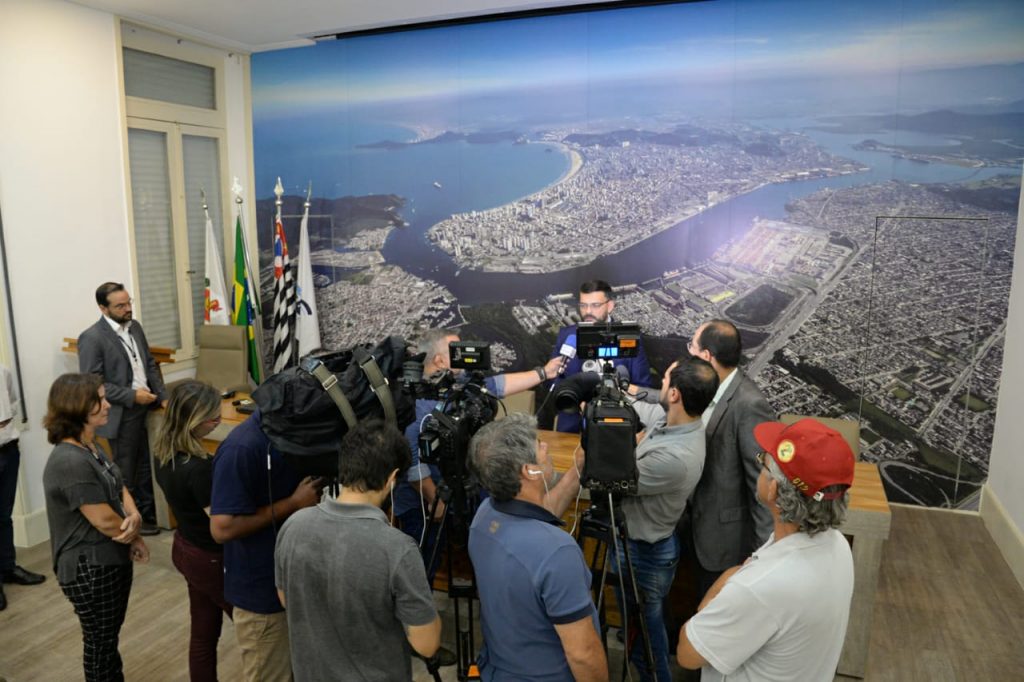Published in fev 18 2020 - 15:18

Zoning plan for 2020 forecasts 50% capacity increase until 2040, reaching 240 million tons
Santos Port Authority (SPA) presented, on Monday the 17th, the new zoning of the Port of Santos to the press. Also known as PDZ (Zoning and Development Plan, acronym in Portuguese), the plan is an instrument of sustainable planning for the rational development of port activities and area occupation in the long term. The new PDZ defines the occupation of areas considering an increase of approximately 60% in the movement of cargo, for 214.9 million tons until 2040, with a two-digit capacity growth for each commercial chain.
The PDZ’s main guidelines are operational efficiency and port-city integration. Regarding operational efficiency, it foresees the consolidation of areas for the clustering of cargo, berth dedication for contiguous terminals and the rise in participation for the railway modal in operations. As for the integration with the city, the plan includes solutions for access interference, destination of the historic Valongo area to passengers and cruise ships, and the development of a masterplan for the preservation of historic and cultural property, as declared by SPA’s CEO, Casemiro Tércio Carvalho, and the Port Planning Superintendent, Bruno Stupello, who coordinated and detailed the proposal.
SPA’s CEO highlighted that the plan inaugurates a new stage in the relation between port and city, grounded in the concern with sustainable development. “It’s about giving more efficiency to cargo movement, while also ensuring improvement in the citizen’s quality of life”. Another mentioned question was the conception of the Plan considering a new management reality for the Port Authority, as an agent of commercial cargo and investment attraction, forecasting, as such, an even larger increase in growth.
This PDZ has been elaborated during last year from the official databases of cargo chains, with projection and adjustments according to market information, as well as the economic production in the port’s hinterland. The starting point was the Master Plan, a portuary planning instrument developed by the Ministry of Infrastructure (Minfra). Published in April 2019, the Master Plan establishes ten months for SPA to submit a corresponding PDZ to the National Port and Waterway Transports Secretariat (SNTPA), connected to Minfra.
The plan encompasses not just the needs for capacity expansion but also the municipality’s demands, promoting zoning changes and accesses improvement. “The Port will be better prepared to comply to the full demand of its hinterland, and still aggregate new cargo”, said Stupello.
The new PDZ was presented and discussed with over 30 entities, not only from the port sector but also from the society. The first presentation was made to the Port Authority Council (CAP), integrated by representatives of the market, of port workers and public power. The other presentations were made to class associations, worker unions, end users’ representatives, the Lawyer Order of Brazil (OAB), the Santos Commercial Association and representatives of the local governments of Santos and Guarujá, among others. After the contributions made by these peers, SPA has incorporated some of the suggestions, such as the destination of a specific area for operators to move cargo on public harbor.
Capacity Improvement
Projections made in the Plan point to an installed capacity of 240.6 million tons in 2040, which is 50% more than the current scenery. Answering to guidelines from Minfra of increasing rail participation in ports, the modal’s forecasted movement should see an increase of over 90%, raising the the current 33% rail participation to 40% in the estimated scenery.
The installments destined to containers will see the largest capacity growth amongst all cargo: a 64% high, from 5.4 million TEU (standard 20-feet container equivalent unit) to 8.7 milliion TEU.
With an increase of 25.6 million tons, the movement capacity for vegetable-origin solid bulk will go from the current 69.7 million to 95.3 million tons, an almost 30% increase.
For chemical and combustible liquid bulk capacity, implementation of new mooring berths and the expansion of tanking volume will raise the current from 16 million tons to 22.4 million tons, in a 40% increase.
As for pulp and paper, a predominantly rail-transported cargo, capacity offer will increase from 7.1 million tons to 10.5 million tons, a 50% growth.
Port-City Integration
In that aspect, the Plan establishes guidelines such as the elimination of railroad crossings both for rail and road traffic, ensuring greater safety and agility in the displacement of workers and public circulating in and around port areas. It also seeks to promote activity in the historic city center with the dedication of old port areas to the implementation of a passenger terminal, which could aggregate up to 8 mooring berths in the Valongo region.
The plan includes also the destination of the Prainha area, in Guarujá, for storage and movement of general cargo, besides the preservation of cultural and historic property under Port Authority’s control.
About Santos Port Authority
Santos Port Authority is a public company connected to the Ntaional Port and Waterway Secretariat (SNPTA) of the Ministry of Infrastructure (MINFRA). It is responsible for the logistic planning and for the administration of the Organized Port of Santos’ infrastructure, the largest of Latin America, through which almost a third of the Brazilian trade balance is moved. With 7,8 million square meters, the port is located 70 Km from the metropolitan region of São Paulo, and contains 43¹ maritime and retroport terminals, distributed among the municipalities that make the two margins of the port’s estuary: Santos (right) and Guarujá (left).
¹Some terminals operate two types of cargo, and have therefore been considered in duplicity.
More info (bilingual):
www.linkedin.com/company/santosportauthority
More info (in portuguese):
